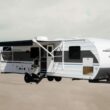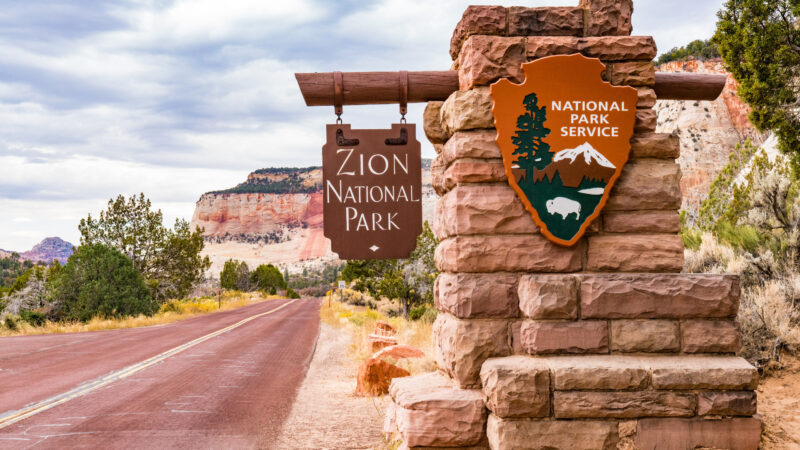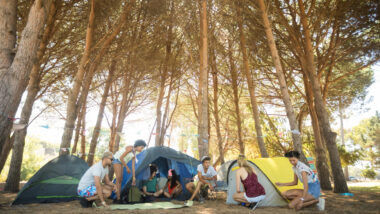Table of Contents Show
Utah has five amazing national parks: Zion, Bryce Canyon, Capitol Reef, Canyonlands, and Arches. Of these “Big Five,” Zion National Park is the most popular and provides developed campgrounds for RVers who prefer camping in less primitive locations.
Let’s take a closer look at Zion National Park camping so you can start planning to enjoy the beauty and geologic wonder of this southwestern Utah park.
About Zion National Park
Zion, Utah’s most-visited national park, lies in the southwestern part of the state. More than five million people visited in 2021, putting Zion at number 10 for the most visited parks in the country.
It includes more than 90 miles of trails, three developed campgrounds, and 232 square miles of plateaus, canyons, cliffs, and waterfalls.
More than 1,000 plants live in this protected area, from cottonwood and firs to yucca. Hundreds of wildlife species call this land home, including the endangered California condors and threatened Mexican spotted owls.
What Is Zion National Park Known For?
Zion is most known for its 2,000-foot cliffs. The Virgin River meanders through narrow, deep sandstone canyons. These geologic formations lure millions of visitors annually who gaze down the Zion Canyon and hike the Narrows.
Many enjoy backpacking, canyoneering, and hiking. The hiking trails range from easy to strenuous so that visitors of all abilities can enjoy the beauty of Zion.
In addition, Zion National Park camping is perfect for stargazers. It’s a stunning scene to witness the jagged silhouette of cliffs against the dark night sky dazzling with thousands of stars.

Can You Camp Inside Zion National Park?
You’ll find numerous backcountry campsites within Zion National Park available for hikers and overnight stays. It also has designated campsites along La Verkin Creek Trail, Hop Valley Trail, West Rim Trail, Virgin River Narrows, and Southwest Desert Trails.
Additional dispersed campsites lie along East Rim, Wildcat Canyon, and Connector Trails. All overnight backpacking in the park requires a wilderness permit.
Zion also has three developed campgrounds. Watchman Campground, located in Zion Canyon, is the only year-round option.
South Campground, located near the Zion Canyon Visitor Center, is closed in the winter. So does Lava Point Campground, which lies off the Kolob Terrace Road about 80 minutes from the south entrance of Zion Canyon.
Is It Hard to Get a Campsite in Zion?
It can be difficult to get a campsite in Zion National Park if you don’t plan ahead. Watchman Campground allows reservations up to six months in advance and often stays full from April to October.
If you’re not on top of the six-month reservation window, you might have difficulty booking a campsite. Even the more remote location of Lava Point Campground remains full during the peak season.
All three campgrounds have reservation systems, so if you hope to enjoy Zion National Park camping, plan ahead.

Everything You Need to Know About Zion National Park Camping
If you want to book a campsite at Zion National Park, you need to know a few things. First, reservations are required. Don’t drive up to a campground and expect to get a campsite.
And each of the three developed campgrounds offers different amenities and allows only rigs of certain lengths. Let’s learn more about Zion National Park camping.
Watchman Campground
Total Sites: Watchman Campground has 176 sites, 65 RV-only, and 69 tent-only options.
RV Max Length: These sites can only accommodate RVs less than 40 feet long.
Reservations Required: Remember, you must have a reservation.
Price: Overnight camping costs $30 a night or $20 for a tent-only spot.
You can easily access the most popular campground in Zion National Park, Watchman Campground. You’ll find it next to the Zion Canyon Visitor Center, a quarter mile from the South Entrance in Springdale, Utah.
All sites have a place to park an RV or pitch a tent, a picnic table, and a fire ring. You can get electric hookups at 95 campsites and cell phone reception but no internet connectivity. Furthermore, you can access the dump station and potable water on-site.
South Campground
Total Sites: South Campground has 117 sites.
RV Max Length: You can’t bring an RV over 40 feet.
Reservations Required: You must make a reservation in advance.
Price: This campground costs $20 a night.
South Campground is near Watchman Campground but has no electric hookups. You can run generators from 8 to 10 a.m. and from 6 to 8 p.m.
Like at Watchman, you don’t get internet connectivity but can receive cell phone reception. All sites have a place to park an RV or pitch a tent, a picnic table, and access to a fire ring. You can use the dump station and access potable water from March through October.
Keep in Mind: Is a National Park Pass for Seniors Worth It? Let’s take a look!
Lava Point Campground
Total Sites: Lava Point only has six campsites.
RV Max Length: This tent-only campground doesn’t allow any RVs.
Reservations Required: Reservations are available on a two-week rolling window at Lava Point Campground.
Price: Luckily, this is a free campground in Zion National Park.
With only six primitive sites, it’s best to make your reservation as soon as possible. It has pit toilets and trash cans but no water. And you must store food in a vehicle or a hard-sided lockable container.
You can’t get cell phone reception or internet at this primitive campground. Finally, you can’t bring vehicles longer than 19 feet to Lava Point.

Do You Need a Park Pass for Zion National Park Camping?
Even if you have a campground reservation or a backcountry permit, you must still pay the entrance fee or have a park pass to enter Zion National Park. A weekly pass remains valid for seven consecutive days and costs $35 for a private vehicle.
The park accepts all annual and lifetime passes upon entry. If you plan on visiting Zion National Park several times throughout the year, you may want a Zion Annual Pass, which costs $70.
How Many Days in Zion Is Enough?
Depending on what you want to do in Zion, a visit may include two or three days or up to a week.
The park is a hiker’s paradise, so if you enjoy this outdoor activity, you may want to stay longer than someone watching a sunset at the Kolob Canyons Viewpoint. Or you can complete the Zion Canyon Drive in a couple of hours.
For most of the year, the Zion Shuttle is in operation to reduce the number of vehicles in the park. The shuttle provides easy access to most of the popular viewpoints and trailheads.
With some planning, you could see Zion in just a couple of days. If you want to move slower and enjoy the scenery more, consider staying for a week.
Keep in Mind: While you’re in Zion, consider hiking Angels Landing! Before you hit the trail, here’s everything you need to know about this hike
Book Early for Your Chance of Camping in Zion National Park
Camping at Zion National Park is a one-of-a-kind experience. Watchman Campground and South Campground both offer amazing stargazing opportunities.
And staying within proximity of the Zion Shuttle makes traveling to the trailheads and overlooks much easier. So make those reservations early for Zion National Park camping and start planning your trip to Utah’s most-visited park.
When will you enjoy the vibrant colors and towering cliffs of southwest Utah?






